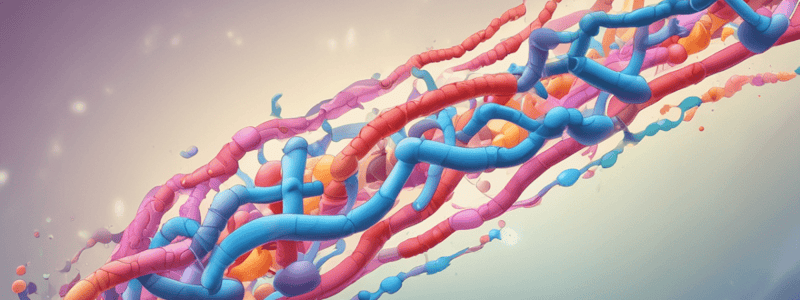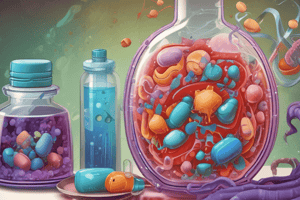Podcast
Questions and Answers
What is the name of the ring structure found in macrolides?
What is the name of the ring structure found in macrolides?
- Sugar residue ring
- Ribosome binding ring
- Macrocyclic lactone ring (correct)
- Cyclic peptide ring
How do macrolides function in preventing protein production?
How do macrolides function in preventing protein production?
- By targeting the outer membrane of bacteria
- By targeting the cytoplasm of bacteria
- By targeting ribosomes and preventing protein production (correct)
- By targeting DNA replication and transcription
What is one mechanism of resistance to macrolides?
What is one mechanism of resistance to macrolides?
- Enhanced protein production
- Improved cell wall synthesis
- Increased DNA replication
- Inhibition of drug entry and accumulation (correct)
What is the name of the gene that encodes an efflux pump that impairs accumulation of macrolides?
What is the name of the gene that encodes an efflux pump that impairs accumulation of macrolides?
What is the effect of methylation of the ribosome in bacteria?
What is the effect of methylation of the ribosome in bacteria?
What is the name of the gene that encodes an enzyme that methylates the ribosome binding site?
What is the name of the gene that encodes an enzyme that methylates the ribosome binding site?
What is the effect of mutations that occur in the ribosome binding site?
What is the effect of mutations that occur in the ribosome binding site?
What is the consequence of resistance to one member of the macrolide group?
What is the consequence of resistance to one member of the macrolide group?
What is the mechanism of action of rifamycins?
What is the mechanism of action of rifamycins?
Why are rifamycins often used in combination with other agents?
Why are rifamycins often used in combination with other agents?
What is the consequence of a single mutation in the bacterial gene that encodes RNA polymerase?
What is the consequence of a single mutation in the bacterial gene that encodes RNA polymerase?
Which rifamycin is most commonly used to treat staphylococcal infections?
Which rifamycin is most commonly used to treat staphylococcal infections?
What is the advantage of using rifampin alone in prophylaxis against Neisseria meningitidis and Haemophilus influenzae?
What is the advantage of using rifampin alone in prophylaxis against Neisseria meningitidis and Haemophilus influenzae?
Why is rifabutin preferred over rifampin in individuals being treated for tuberculosis and HIV infection?
Why is rifabutin preferred over rifampin in individuals being treated for tuberculosis and HIV infection?
What is the structure of rifamycins?
What is the structure of rifamycins?
What is the effect of rifampin on the cytochrome P-450 system?
What is the effect of rifampin on the cytochrome P-450 system?
What is the mechanism of action of lincosamide antibiotics?
What is the mechanism of action of lincosamide antibiotics?
Why are lincosamide antibiotics used as adjunctive therapy in toxic shock syndrome?
Why are lincosamide antibiotics used as adjunctive therapy in toxic shock syndrome?
What is the reason for clindamycin's resistance to some strains of bacteria?
What is the reason for clindamycin's resistance to some strains of bacteria?
What type of bacteria is clindamycin most active against?
What type of bacteria is clindamycin most active against?
What is the major toxicity of clindamycin?
What is the major toxicity of clindamycin?
What is the primary mechanism by which tetracyclines interact with the bacterial ribosome?
What is the primary mechanism by which tetracyclines interact with the bacterial ribosome?
What is the reason for Clostridium difficile overgrowth in the bowel?
What is the reason for Clostridium difficile overgrowth in the bowel?
What is the name of the related class of antibiotics to which tigecycline belongs?
What is the name of the related class of antibiotics to which tigecycline belongs?
What is pseudomembranous colitis characterized by?
What is pseudomembranous colitis characterized by?
Which of the following is a common mechanism of resistance to tetracyclines?
Which of the following is a common mechanism of resistance to tetracyclines?
What is the name of the structure that allows tetracyclines to interact with the bacterial ribosome?
What is the name of the structure that allows tetracyclines to interact with the bacterial ribosome?
What is another side effect of clindamycin besides Clostridium difficile colitis?
What is another side effect of clindamycin besides Clostridium difficile colitis?
Which of the following is NOT a member of the tetracycline class of antibiotics?
Which of the following is NOT a member of the tetracycline class of antibiotics?
What is the result of the interaction between tetracyclines and the bacterial ribosome?
What is the result of the interaction between tetracyclines and the bacterial ribosome?
What is the function of ribosomal protection proteins in bacterial resistance to tetracyclines?
What is the function of ribosomal protection proteins in bacterial resistance to tetracyclines?
Which of the following tetracycline antibiotics has been recently approved for use?
Which of the following tetracycline antibiotics has been recently approved for use?
What is linezolid?
What is linezolid?
How does linezolid prevent protein synthesis?
How does linezolid prevent protein synthesis?
Why are some aerobic gram-negative bacilli resistant to linezolid?
Why are some aerobic gram-negative bacilli resistant to linezolid?
What is the mechanism of resistance to linezolid?
What is the mechanism of resistance to linezolid?
What type of bacteria is linezolid active against?
What type of bacteria is linezolid active against?
Which of the following bacteria is linezolid not active against?
Which of the following bacteria is linezolid not active against?
What is the name of the class of antibacterial agents that linezolid belongs to?
What is the name of the class of antibacterial agents that linezolid belongs to?
What is the unique feature of linezolid's structure?
What is the unique feature of linezolid's structure?
Flashcards are hidden until you start studying
Study Notes
Rifamycins
- Rifamycins have a similar structure that includes an aromatic nucleus linked by an aliphatic "handle" on both ends.
- They inhibit bacterial RNA polymerase by nestling deep into the DNA/RNA tunnel of the enzyme and sterically blocking elongation of the nascent mRNA molecule.
- Resistance to rifamycins develops easily and can result from single mutations in the bacterial gene that encodes RNA polymerase, which change only a single amino acid at the site where the rifamycins bind to RNA polymerase.
- Rifamycins are usually used in combination with other agents to prevent the emergence of resistant strains.
- Rifampin is used in combination regimens for the treatment of mycobacterial infections and is also effective as monotherapy for prophylaxis against Neisseria meningitidis and Haemophilus influenzae.
Macrolides
- Macrolides consist of a large cyclic core called a macrocyclic lactone ring, which is decorated with sugar residues.
- They bind tightly to the 50S subunit of the bacterial ribosome at a location that blocks the exit of the newly synthesized peptide, preventing protein production.
- Resistance to macrolides occurs by one of several mechanisms, including:
- Inhibition of drug entry and accumulation, which can be mediated by efflux pumps.
- Enzyme-mediated ribosome binding site alteration, which can be encoded by genes such as the erm gene in S.pneumoniae.
- Mutation of the ribosome binding site, which is a rare mechanism.
- Resistance to one member of the macrolide group usually implies resistance to all members.
- Macrolides are active against various bacteria, including Streptococcus pneumoniae and Haemophilus influenzae.
Tetracyclines and Glycylcyclines
- Tetracyclines have a core structure consisting of four fused six-membered rings, which allows them to interact with the 30S subunit of the bacterial ribosome and prevent binding by tRNA molecules loaded with amino acids.
- Resistance to tetracyclines occurs by one of two mechanisms:
- Acquisition of exogenous genes that encode efflux pumps, which prevent intracellular accumulation of these drugs.
- Acquisition of genes that encode ribosomal protection proteins, which alter the conformation of the bacterial ribosome such that tetracyclines no longer bind.
- Tigecycline is a glycylcycline antibiotic that has recently been approved for use.
Lincosamides
- Lincosamide antibiotics bind to the 50S subunit of the bacterial ribosome and inhibit protein synthesis.
- Clindamycin's mechanism of action is very similar to that of the macrolides, and its binding sites overlap with those of the macrolides.
- Clindamycin is active against two groups of bacteria: aerobic gram-positive bacteria and anaerobic bacteria, including staphylococci and streptococci.
- Clindamycin is not useful against aerobic gram-negative bacteria due to its inability to penetrate their outer membranes.
Linezolid
- Linezolid is a synthetic antibiotic that binds to the 50S subunit of the bacterial ribosome, preventing association of this subunit with the 30S subunit and inhibiting protein synthesis.
- Resistance to linezolid has already been detected and is the consequence of a single amino acid mutation within the gene encoding a portion of the ribosome.
- Linezolid has excellent activity against most aerobic gram-positive bacteria, including methicillin-resistant staphylococci, penicillin-resistant S.pneumoniae, and vancomycin-resistant enterococci.
- Some aerobic gram-negative bacilli, such as Escherichia coli, are intrinsically resistant to linezolid due to the production of efflux pumps active against this compound.
Studying That Suits You
Use AI to generate personalized quizzes and flashcards to suit your learning preferences.




